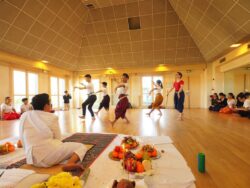Master weaver Dixie Rogers (L; Karuk) with her 2018 ACTA apprentice in Karuk baby basketry, Julia McCovey (R; Yurok, Karuk). Photo: Shweta Saraswat-Sullivan/ACTA.
Tending the Taproot
Opportunities to Support Folk & Traditional Arts in the United States
We “mus tek cyear a de root fa heal de tree” — we must take care of the roots to heal the tree.
— Gullah Geechee Proverb
A new publication of the Alliance for California Traditional Arts
Researched and written by Amy Kitchener, M.A., Shweta Saraswat-Sullivan, Ph.D., and Lily Kharrazi, M.A.
Every cultural community in the United States is rooted in a sense of belonging, shared by members, and anchored by collective wisdom and aesthetics. These roots of cultural heritage are maintained, strengthened, and expanded through the practice of folk and traditional arts. The realities of slavery, displacement, structural racism, systemic poverty, and cultural appropriation have tested the strength of these cultural roots. The stresses are even more apparent, viewed against our present-day national reckoning with these harms amidst a global pandemic. In this context, traditional arts practices are potent political acts of social belonging, power, and justice. From this field have emerged works and artists of beauty, technical prowess, and meaning. Music, dance, craft, oral tradition, foodways, and other heritage ways are transmitted and engaged in as part of the cultural life of a community. We invoke the metaphor of the taproot, a term borrowed from botany, to describe a community’s central cultural root, growing downward to a considerable depth. In our extended metaphor, key artists and culture bearers tend these taproots, serving as teachers, creators, and visionaries as well as advocates, managers, fundraisers, curators, planners, and actors.

Yet, the vast majority of traditional artists—and the organizations, collectives, and informal networks of practice they lead—have never received the philanthropic investment that would allow them to realize long-term visions for change in their communities. There has been little national effort to invest in, convene, or capitalize these artists and organizations, a fundamental inequity in arts funding in the US. As a result, artist-leaders at the pinnacle of traditional arts practices lack the financial and infrastructure stability to plan for succession and to set goals at a more forward-thinking scale for their organizations.

This report, Tending the Taproot: Opportunities to Support Folk & Traditional Arts in the United States, presents the findings of the Alliance of California Traditional Arts’ (ACTA) Taproot Initiative. This national planning effort, aimed to re-center traditional and folk artists and their art forms as catalysts for transformation and restoration in our larger society, is aligned with other important movements in the arts and culture sector to spur critical thinking and action during this hallmark moment of radical change. The report describes the resource landscape of folk and traditional arts. It offers operational recommendations as a call to action to support taproot artist-leaders and organizations with focused investment in funding and development to do more and do better, resources for infrastructure, elevated national recognition, and new standards for robust data and research infrastructure. Our recommendations are evidenced by qualitative and quantitative research findings, grounded in ACTA’s quarter century of experience as a funder and advocate in this field.
Here is our challenge to national, regional, local, and philanthropic organizations and funders of folk and traditional arts:
- Invest in taproot artists and culture bearers through sustained fellowships for accomplished artists and multi-year support for large arts projects, institute continuing operating support for artists’ cultural enterprises, and provide technology transfer and training for taproot artists and administrators
- Invest in ongoing operating funding to the many organizations that sustain the taproot ecosystem and that develop and host key programs and performances; invest in economic opportunities and training for organizations and culture bearers to develop and expand their arts-related income
- Raise the visibility and position of this field through a national communications strategy and partnerships with public agencies, philanthropies, and private partners to widely disseminate traditional arts education and materials to the public
- Update data collection and research infrastructure with investment in new quantitative and qualitative research to illuminate the roles and impact of traditional artists and their organizations; upgrade cultural heritage documentation, data collection, and dissemination infrastructure to establish new standards in the field; elevate the regional and national research repositories of living cultural heritage in collaboration with the American Folklife Center at the Library of Congress
Or preview the report via our interactive magazine preview below.


